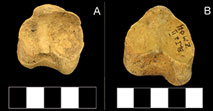Crossref Citations
This article has been cited by the following publications. This list is generated based on data provided by
Crossref.
Bogaard, Amy
Fochesato, Mattia
and
Bowles, Samuel
2019.
The farming-inequality nexus: new insights from ancient Western Eurasia.
Antiquity,
Vol. 93,
Issue. 371,
p.
1129.
Marić, Miroslav
and
Mirković-Marić, Neda
2020.
The Tisza divide. The missing late Neolithic transformation in the north Bačka region of Serbia.
Quaternary International,
Vol. 560-561,
Issue. ,
p.
78.
Boyadzhiev, Kamen
2020.
The transition to the Late Neolithic in the Upper Thracian Plain.
Quaternary International,
Vol. 560-561,
Issue. ,
p.
45.
Filioglou, Dimitris
Prummel, Wietske
and
Çakirlar, Canan
2021.
Animal husbandry in Classical and Hellenistic Thessaly (Central Greece): A zooarchaeological perspective from Almiros.
Journal of Archaeological Science: Reports,
Vol. 39,
Issue. ,
p.
103164.
Namdar, Linoy
Vardi, Jacob
Paz, Yitzhak
and
Sapir-Hen, Lidar
2021.
Variation in economic specialization as revealed through the study of Pottery Neolithic faunal assemblages from the southern Levant.
Archaeological and Anthropological Sciences,
Vol. 13,
Issue. 11,
Thomas, Richard
Bellis, Lauren
Gordon, Rebecca
Holmes, Matilda
Johannsen, Niels N.
Mahoney, Meghann
and
Smith, David
2021.
Refining the methods for identifying draught cattle in the archaeological record: Lessons from the semi-feral herd at Chillingham Park.
International Journal of Paleopathology,
Vol. 33,
Issue. ,
p.
84.
Radivojević, Miljana
and
Roberts, Benjamin W.
2021.
Early Balkan Metallurgy: Origins, Evolution and Society, 6200–3700 BC.
Journal of World Prehistory,
Vol. 34,
Issue. 2,
p.
195.
Price, Max
Fisher, Michael
and
Stein, Gil
2021.
Animal Production and Secondary Products in the Fifth Millennium BC in northern Mesopotamia.
Paléorient,
p.
9.
Ameen, Carly
Benkert, Helene
Fraser, Tamsyn
Gordon, Rebecca
Holmes, Matilda
Johnson, Will
Lauritsen, Malene
Maltby, Mark
Rapp, Karina
Townend, Tess
Baker, Gary Paul
Jones, Laura May
Vo Van Qui, Camille
Webley, Robert
Liddiard, Robert
Sykes, Naomi
Creighton, Oliver H.
Thomas, Richard
and
Outram, Alan K.
2021.
In search of the ‘great horse’: A zooarchaeological assessment of horses from England (AD 300–1650).
International Journal of Osteoarchaeology,
Vol. 31,
Issue. 6,
p.
1247.
Holmes, Matilda
Thomas, Richard
and
Hamerow, Helena
2021.
Identifying draught cattle in the past: Lessons from large-scale analysis of archaeological datasets.
International Journal of Paleopathology,
Vol. 33,
Issue. ,
p.
258.
Lin, Minghao
2022.
Origins of Cattle Traction and the Making of Early Civilisations in North China.
p.
57.
Watkins, Trevor
2022.
Doctrines of Neolithic Religiosity.
Journal for the Cognitive Science of Religion,
Vol. 8,
Issue. 2,
Lin, Minghao
2022.
Origins of Cattle Traction and the Making of Early Civilisations in North China.
p.
1.
Lin, Minghao
2022.
Origins of Cattle Traction and the Making of Early Civilisations in North China.
p.
181.
Marković, Nemanja
Bulatović, Jelena
Krstić, Nikola
Marinković, Darko
Pantović, Ivana
Russell, Nerissa
Rothschild, Bruce
and
Marić, Miroslav
2022.
Severe traumatic lesions in the Late Neolithic cattle from the site of At‐Vršac, Serbia.
International Journal of Osteoarchaeology,
Vol. 32,
Issue. 6,
p.
1285.
Lin, Minghao
2022.
Origins of Cattle Traction and the Making of Early Civilisations in North China.
p.
71.
Bulatović, Jelena
Marković, Nemanja
Krstić, Nikola
Bulatović, Aleksandar
Mitrović, Marko
and
Marinković, Darko
2022.
Animal diseases in the Central Balkan Eneolithic (ca. 4500–2500 BC)—A diachronic perspective on the site of Bubanj, south‐eastern Serbia.
International Journal of Osteoarchaeology,
Vol. 32,
Issue. 2,
p.
303.
Kamjan, Safoora
Erdil, Pınar
Hummel, Esmee
Çilingiroğlu, Çiler
and
Çakırlar, Canan
2022.
Traction in Neolithic Çatalhöyük? Palaeopathological analysis of cattle and aurochs remains from the East and West Mounds.
Journal of Anthropological Archaeology,
Vol. 66,
Issue. ,
p.
101412.
Lin, Minghao
Luan, Fengshi
Fang, Hui
Xu, Hong
Zhao, Haitao
Hu, Songmei
Qian, Yaopeng
Ma, Xiaolin
and
Barker, Graeme
2022.
Bulls for sacrifice, cows for work? Morphometric models suggest that female cattle were used for traction in the Chinese Bronze Age Late Shang dynasty (ca. 1300–1046 BCE).
The Holocene,
Vol. 32,
Issue. 1-2,
p.
70.
García-Vázquez, Ana
Bălășescu, Adrian
Vasile, Gabriel
Golea, Mihaela
Radu, Valentin
Opriș, Vasile
Ignat, Theodor
Culea, Mihaela
Covătaru, Cristina
Sava, Gabriela
and
Lazăr, Cătălin
2023.
Unravelling the resilience of the KGK VI population from the Gumelnița site (Romania) through stable isotopes.
Scientific Reports,
Vol. 13,
Issue. 1,


